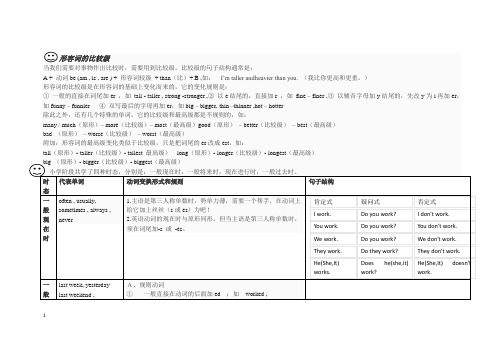比较级的基本结构
- 格式:pdf
- 大小:122.56 KB
- 文档页数:15

比较级比较级是英语语法中的一个重要概念,用于比较两个事物或者两个行动的差异或者优劣。
在英语中,比较级通常通过在形容词和副词前面加上-er来构成,或者在前面加上more来构成。
本文将介绍比较级的用法,以及一些需要特殊注意的情况。
首先,我们来看形容词的比较级。
当我们需要比较两个事物或者两个人物的特征时,通常使用形容词的比较级。
比较级的构成方式很简单,一般在形容词后面加上-er,例如taller(更高的)、faster (更快的)、stronger(更强壮的)。
当形容词以辅音字母+y结尾时,需要将y变为i,再加上-er,例如funnier(更有趣的)、easier(更容易的)。
不过需要注意的是,当形容词本身以重读闭音节结尾,并且末尾只有一个辅音字母时,需要双写最后一个辅音字母,再加上-er,例如bigger(更大的)、hotter(更热的)。
除了使用-er构成比较级外,我们还可以使用more来构成比较级。
一般来说,多音节和部分双音节形容词都需要使用more来构成比较级,例如beautiful(更美的)、interesting(更有趣的)。
一些以不规则方式构成比较级的形容词需要特别注意,例如good(好的)的比较级是better(更好的)、bad(坏的)的比较级是worse(更差的)、little(小的)的比较级是less(更少的)。
在比较级的语境中,我们还常常用到than来表示比较的对象。
比较级通常用来比较两个事物或者两个人物的特征,然后使用than来连接比较的对象。
比如,Tom is taller than John(汤姆比约翰更高)。
除了形容词的比较级,副词也有自己的比较级。
和形容词的比较级一样,一般在副词前面加上-er来构成比较级,例如faster(更快地)、harder(更努力地)。
不过需要注意的是,部分以-ly结尾的副词需要使用more来构成比较级,例如more slowly(更慢地)、more carefully(更仔细地)。


1233、一般疑问句:是指询问事实的句子,此类句子必须用“yes”,或“no”来回答。
如:Are you astudent? Yes, I am / No, I’m not.Is she a doctor? Yes, sheis. / No, she isn’t.Does he work in a hospital? Yes, he does./ No, he doesn’t.Are there four fans in our classroom? Yes, there are. / No, there aren’t.Did you watch TV yesterday evening? Yes, I did. / No, I didn’t.☆小结:一般疑问句是在肯定句的基础上,①把动词be调到首位,其他照写,末尾标点符号变成问号即可。
②没有动词be的句子则要在句首加上一个助动词(do,does,did)再把紧跟在后面的动词变回原形,末尾标点符号变成问号即可。
这三个助动词也要根据人称和时态来选择,其中“does”只用于一般现在时主语是第三人称单数的情况,而“did”只用于一般过去时,不论主语是什么人称和数,都用“did” 。
一般疑问句有个重要的原则就是问和答要一致,即问句里的第一个单词(助动词)和简略答句里的这个词是一致的。
4、特殊疑问句:以特殊疑问词(what , where , who , which , when , whose , why ,how等)开头引导的句子。
此类句子应该问什么就答什么,不能用“yes 、no”来回答。
如:What is this?It’s a computer.What does he do?He’s a doctor.Where ar e yougoing? I’m going to Beijing.Who played football with you yesterday afternoon? Mike.Which seasondo you like best? Summer. When do youusually get up? I usually get up at 6:30.Whose skirt isthis? It’s Amy’s.Why do you likespring best? Because I can plant trees.How are you?I’m fine. / I’m happy. How did you go to Xinjiang?I went to Xinjiang by train.☆其中how又可以和其他一些形容词连用组成特殊疑问词组用来提问,如:how many(多少(数量)), how much(多少(钱)), how tall(多高), how long (多长), how big(多大), how heavy(多重)例句:How many pencils do youhave? I have three pencils.How many girls can yousee? I can see four girls.How many desks are therein your classroom? There are 51.☆小结:how many 用来提问可数名词的数量,主要有以上三种句式搭配,How many + 名词复数+ do you have? 你有多少……?How many + 名词复数+ can you see? 你能看见多少……?How many + 名词复数+ are there…?有多少……?4。

比较级和最高级的构成1.规则变化:⑴单音节以及少数双音节的词,在后面直接加–er(比较级)-est(最高级)。
加er,加est的规则如下:①直接在词尾加- er,-est②以-e结尾的,在后面加-r , -st 例如:large—larger—largest;③以辅音字母+y结尾的词,把y变成i,再加-er , -est 例如:heavy—heavier—heaviest;[注〕shy ---- shyer , shyest / shier , shiest④重读闭音节的词,要双写词尾字母,再加-er , -est 例如:hot-hotter-hottest⑵.多音节的词,要在前面加—more. --most、例如:more beautiful, most beautiful.〔注〕少数单音节词前面加more-, most- 构成比较级和最高级tired ---- more tired , most tired fond ----- more fond , most fondglad ----- more glad , most glad bored ---- more bored , most boredpleased---- more pleased , most pleased2.不规则变化good /well------- better ,best bad/badly/ill------ worse , worstmany/much-------more , most little ------ less , leastfar ---- farther, farthes / firther , furthest old ---- older , oldest (GA)---- older , oldest / elder , eldest (GB)三.下列形容词和副词的比较级和最高级有两种形式(实记)cruel----- crueler, cruelest /more cruel , most cruelstrict---- stricter , strictest /more strict , most strictoften----- oftener , oftenest /more often , most oftenfriendly------ friendlier , friendliest /more friendly , most friendlyclever----- cleverer, cleverest /more clever , most clever四下列形容词和副词没有比较级和最高(即表示‖最高程度‖或‖绝对状态‖的形容词和副词没有比较级和最高级)empty , wrong , perfect , unique , extreme , excellent , favourite (GB)/ favorite (GA) , true , right , correct , extremely ...名词变复数的情形如下:1) 一般情况下,在词尾加-s. 例如: bags,maps,pens,desks,workers2) 名词以[s],[z],[ ],[t ],[d ]等音结尾在其后加-es, 如词尾已有e ,只加-s。

比较级的六种用法结构比较级在英语中是一个非常常见且重要的语法结构,用来比较两个物品、人或者情况之间的差异。
比较级的用法非常灵活,可以用在不同的句子结构中,以表达不同的比较关系。
接下来我们将重点讨论比较级的六种常见用法结构,让我们一探究竟。
1. 比较级 + than比较级 + than 结构表示一个物品、人或情况比另一个更高一些,更大一些,更好一些等。
这种结构通常用来表达物品的物理或者定性特征的比较。
例如:- The car is faster than the bicycle.- She is taller than her sister.- This restaurant is better than the one we went to last week.2. The + 比较级 + of (两者之中的更……之一)The + 比较级 + of 结构用来表示两个人或物中的一个(不论指定的是增减或状态)比另一个更……之一。
例如:- John is the smarter of the two brothers.- This is the more expensive of the two dresses.- This sandwich is the tastier of the two.3. 比较级 + than ever before比较级 + than ever before 结构表示某一物质或情况的水平高于之前的水平。
例如:- The new phone is faster than ever before.- She is more confident now than ever before.- The pollution in this city is worse than ever before.4. 越来越 + 比较级越来越 + 比较级结构用来表达某一物质或情况的水平不断增加。

⽐较级和最⾼级的构成⽐较级和最⾼级的构成1.规则变化:⑴单⾳节以及少数双⾳节的词,在后⾯直接加–er(⽐较级)-est(最⾼级)。
加er,加est的规则如下:①直接在词尾加- er,-est②以-e结尾的,在后⾯加-r , -st 例如:large—larger—largest;③以辅⾳字母+y结尾的词,把y变成i,再加-er , -est 例如:heavy—heavier—heaviest;[注〕shy ---- shyer , shyest / shier , shiest④重读闭⾳节的词,要双写词尾字母,再加-er , -est 例如:hot-hotter-hottest⑵.多⾳节的词,要在前⾯加—more. --most、例如:more beautiful, most beautiful.〔注〕少数单⾳节词前⾯加more-, most- 构成⽐较级和最⾼级tired ---- more tired , most tired fond ----- more fond , most fondglad ----- more glad , most glad bored ---- more bored , most boredpleased---- more pleased , most pleased2.不规则变化good /well------- better ,best bad/badly/ill------ worse , worstmany/much-------more , most little ------ less , leastfar ---- farther, farthes / firther , furthest old ---- older , oldest (GA)---- older , oldest / elder , eldest (GB)三.下列形容词和副词的⽐较级和最⾼级有两种形式(实记)cruel----- crueler, cruelest /more cruel , most cruelstrict---- stricter , strictest /more strict , most strictoften----- oftener , oftenest /more often , most oftenfriendly------ friendlier , friendliest /more friendly , most friendlyclever----- cleverer, cleverest /more clever , most clever四下列形容词和副词没有⽐较级和最⾼(即表⽰‖最⾼程度‖或‖绝对状态‖的形容词和副词没有⽐较级和最⾼级)empty , wrong , perfect , unique , extreme , excellent , favourite (GB)/ favorite (GA) , true , right , correct , extremely ...名词变复数的情形如下:1) ⼀般情况下,在词尾加-s. 例如: bags,maps,pens,desks,workers2) 名词以[s],[z],[ ],[t ],[d ]等⾳结尾在其后加-es, 如词尾已有e ,只加-s。
比较级的用法知识点总结1.可以修饰比较级的词,much,a lot,far,…的多a little,a bit,…一点儿even甚至,still仍然例如,Lesson One is much easier than Lesson Two.第一课比第二课容易得多。
She drives still more carefully than her husband.她开车仍然比她丈夫还认真。
2.比较级常用的句型结构(1)“甲+be+(倍数)+形容词比较级+than+乙”表示“甲比乙…”或“甲比乙…几倍”例如,Tom is taller than Kate.汤姆比凯特高。
“甲+实意动词+(倍数)+副词比较级+than+乙”表示“甲比乙…”或“甲比乙…几倍”例如,I got up earlier than my mother this morning.我今天早晨起床比我妈妈还早。
(2)“甲+be+形容词比较级+than+any other+单数名词(+介词短语)”表示“甲比同一范围的任何一个人/物都……”,含义是“甲最……”。
例如,The Yangtze River is longer than any other river in China.=The Yangtze River is longer than any of the other rivers in China.长江比中国的任何一条其他的河都长。
=The Yangtze River is longer than the other rivers in China.长江比中国的其他所有的河都长。
=The Yangtze River is the longest river in China.长江是中国最长的河流。
注意:The Yangtze River is longer than any river in Japan.长江比日本的任何一条河都长。
比较级和最高级的用法比较级和最高级是英语语法中用来表示两个或多个事物之间的比较和最高程度的形式。
在日常交流和写作中,正确使用比较级和最高级可以丰富表达,使语言更生动有趣。
本文将详细介绍比较级和最高级的用法。
一、比较级的用法1. 形容词和副词比较级用于形容词和副词,表示比较两个事物或多个事物之间的差异。
一般形成比较级的方式是在词尾加上-er,或者在前面加more。
例如:- 他比我高一点。
He is taller than me.- 这本书比那本书更有趣。
This book is more interesting than that one.2. 不规则比较级有一些形容词和副词的比较级是不规则变化的,需要特别注意。
例如:- 好:better- 多:more- 远:farther/further3. 比较级的结构比较级常与than连用,表示比较的对象。
例如:- 这本书比那本书更有趣。
This book is more interesting than that one.- 猫比狗更独立。
Cats are more independent than dogs.4. 与形容词修饰词连用比较级可以与形容词修饰词连用,表示程度上的比较。
例如:- 这个城市越来越拥挤。
This city is getting more and more crowded.- 天气越来越热了。
The weather is getting hotter and hotter.二、最高级的用法1. 形容词和副词最高级用于形容词和副词,表示三个或多个事物之间的比较程度。
一般形成最高级的方式是在词尾加上-est,或者在前面加most。
例如: - 他是我们班最高的男生。
He is the tallest boy in our class.- 这是我见过的最有趣的电影之一。
This is one of the most interesting movies I have ever seen.2. 不规则最高级有一些形容词和副词的最高级是不规则变化的,需要特别注意。
(一 )比较级和最高级的构成:1 加-er,-est 构成比较级和最高级。
【1】单音节形容词和副词high-higher-highest hard-harder-hardest 【2】以不发音的 -e 结尾的safe-safer-safest late-later-latest【3】辅音字母要双写的情况:【4】以辅音加 -y 结尾的情况dry-drier-driest merry-merrier-merrist 2 加 more,most 构成比较级和最高级。
【1】多音节的形容词和副词expensive-more expensive-most expensivecarefully-more carefully-most carefully【2】由形容词加 -ly 构成的副词slowly-more slowly-most slowlyhighly-more highly-most highly【3】以-ful,-less,-able,-ous,-ive,-ing 等结尾的双音节形容词useless-more useless-most uselessserious-more serious-most seriuos【4】分词形容词 tired,pleased 及 glad,often,real,right,wrong 等单音节形容词tired-more tired-most tiredglad-more glad-most glad( 3 )形容词、副词的比较级和最高级的不规则构成法。
bad/ill/badly-worse-worstmany/much-more-mostlittle-less-leastfar-farther/further-farthest/furthestold-older/elder-oldest/eldest(二) 比较级和最高级的用法1 比较级的表示法:主语 +be +比较级+than …;主语+谓语+比较级+than …( 1 )不同主语的比较:He is two years younger than I.This machine works better than that one.Li Ming studies harder than Wang Ling.( 2 )同一主语不同方面的比较:She is now happier than she has ever been.The exam was easier than we expected.We have had much more rain this year than last year.( 3 )用于修饰比较级的词: even,(very) much,far,a lot,stillThis book is much thicker than that one.He works even harder than before.( 1 ) 形容词和副词最高级的用法三者或三者以上的比较用最高级。
比较级的构成一、形容词级的构成1. 单音节形容词的比较级以及以-ly, -er, -ow结尾的形容词在词尾加-er;以e 结尾的形容词在词尾直接加-r构成,重读闭音节双写末位字母再加er。
dark→darker; quick→quicker; ; clever→cleverer; simple→simpler; narrow →narrower。
2. 多音节形容词的比较级在其前加more构成。
important→more important; beautiful→more beautiful。
3. 表语形容词以及由分词变来的形容词,在其前加more构成。
afraid →more afraid; interesting→more interesting; pleased→more pleased。
4. 少数形容词的比较级是不规则的。
good/well→better; bad/ill→worse; far→farther / further;much/many→more;little→less5.以辅音加y结尾的,把y变i,加er。
-early→earlier;funny→funnier基本句型原级比较1.由“...as + 形容词 + as...”或“...as + 形容词 + 名词 + as...”构成。
My grandpa is as energetic as a young man.Exercise is as useful a way as any other to lose unwanted weight.I try to find as much information as I can about what happened.2.由“...not so (as) + 形容词 + as...”或“...not so (as) + 形容词 + 名词 + as...”构成。
Luckily the weather was not so wet as it is today.不同级比较1.由“……形容词比较级 + than...”构成。
比较级
Ⅰ.比较级的基本结构
1.由than 构成的比较级:
A + is/are +形容词的比较级+than+B.
A+ 行为动词 + 副词的比较级+than+B.
e.g. The book is cheaper than that one.
I run faster than his brother.
2.由as…as 构成的平行比较级:
1 ) A is /are as +形容词+as.(肯定形式)
A+行为动词 +as +副词+as.(肯定形式)
e.g We are as careful as they.
We write as carefully as them.
2)A is /are not as/so +形容词+as.(否定形式)
A+助动词 +not +行为动词原型 +as +副词+as.(否定形式)
e.g. The boy isn’t as tall as his sister. =The boy is shorter than his
sister. 这个男孩没有他姐姐高。
He doesn’t sing as well as his sister. =He sings worse than his sister. We aren’t as careful as they. =We are less careful than they.
We don’t write as carefully as them.=We write less carefully than they.
3.由more,fewer,less+名词构成的比较级
1)more “比……多”,后接复数名词或不可数名词
I have more news books than my cousin.
He has more milk than I .
2)less “比……少”,后接不可数名词
He has less water than me.
3)fewer“比……少”,后接复数名词
They have fewer flowers than we .
Ⅱ.比较级的特殊结构
1.The more ……,the more…. 越……,就越……(more代表比较级)
e.g. The more careful you are, the fewer mistakes you will make.
你越细心,你犯的错误就越少。
The happier you are, the more friends you will make.
你越快乐,你将会交越多的朋友。
2.more and more 越来越……
Our school is cleaner and cleaner. 我们的校园越来越干净。
Our city becames more and more beautiful.
我们的城市变得越来越漂亮。
I’m sorry the clean water gets dirtier and less.
我难过的是感觉到水越来越脏越来越少。
3.由of构成的比较级,比较级前面加the
Joe is the taller of the two girls.Joe是这两个女孩中较高的。
※在英语中,常用much、even、a little、a lot等词修饰比较级。
e.g. He is much stronger .他强壮的多。
She is a little thinner thanme. 她比我矮一点点。
Ⅲ、比较级的比较对象要一致
e.g. 1.He is fatter than I/me.(次处比较对象是人)
2. My eyes are bigger than yours.
(次处比较对象是人的眼睛,故用yours代替your eyes)
3.The weather in Wuhan is hotter than that in Beijing.
(此处用that代替前面的weather)
Ⅳ、比较级的比较范围要区分
e.g. 1. Li Ping is taller than any other student in his class.
李平比班上任何其他的学生高。
(在同一个班上,李平也是其中之一的学生,故用any other+单数名词)
2. Li Ping is taller than any students
我要拍,我要拍商城,拍拍商城 71yPrCh1TG75。